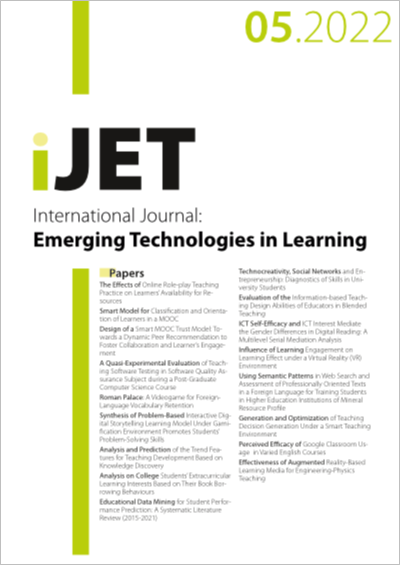ICT Self-Efficacy and ICT Interest Mediate the Gender Differences in Digital Reading: A Multilevel Serial Mediation Analysis
DOI:
https://doi.org/10.3991/ijet.v17i05.25691Keywords:
gender differences, ICT interest, ICT self-efficacy, mediation analysis, PISA readingAbstract
With an increasing number of information has disseminated in the digital form, digital reading, a sub-construct of ICT literacy, is significant for young generations to succeed in the digital era. gender differences, however is ob-served in students’ digital reading performance which calls for meticulous ex-amination. This study aimed to explore whether ICT self-efficacy and ICT in-terest could explain the gender differences in digital reading, and how ICT self-efficacy and ICT interest are associated in explaining the gender differ-ences in digital reading. Data from 6,173 samples from 192 schools in Estonia who took part in the Programme for International Student Assessment (PISA) 2018 were collected. Multilevel serial mediation analysis showed that both ICT self-efficacy and ICT interest mediated the gender differences in digital reading, the lower level of ICT self-efficacy and ICT interest girls had could explain the decrease of their digital reading performance. Results also indicat-ed that girls were not inherently less interested in ICT, and the seemingly less ICT interest girls had was largely owing to their lower level of ICT self-efficacy shaped by the general sex-role stereotype of computer use. Pedagogi-cal intervention on strengthening girls’ ICT self-efficacy was suggested to in-crease girls ICT interest and their digital reading performance to empower them in the digital era.
Downloads
Published
2022-03-14
How to Cite
Yu, H., & Hu, J. (2022). ICT Self-Efficacy and ICT Interest Mediate the Gender Differences in Digital Reading: A Multilevel Serial Mediation Analysis. International Journal of Emerging Technologies in Learning (iJET), 17(05), pp. 211–225. https://doi.org/10.3991/ijet.v17i05.25691
Issue
Section
Papers
License
Copyright (c) 2022 Jie Hu

This work is licensed under a Creative Commons Attribution 4.0 International License.



